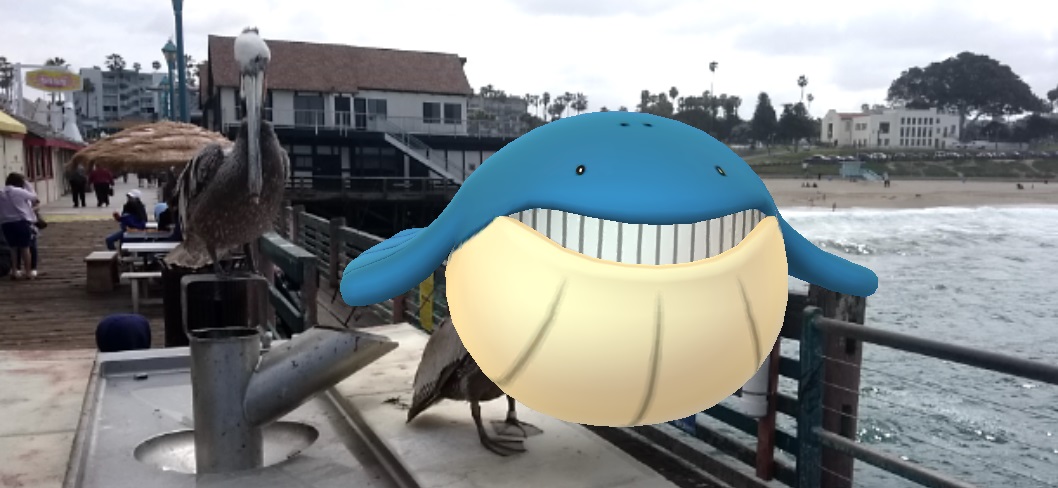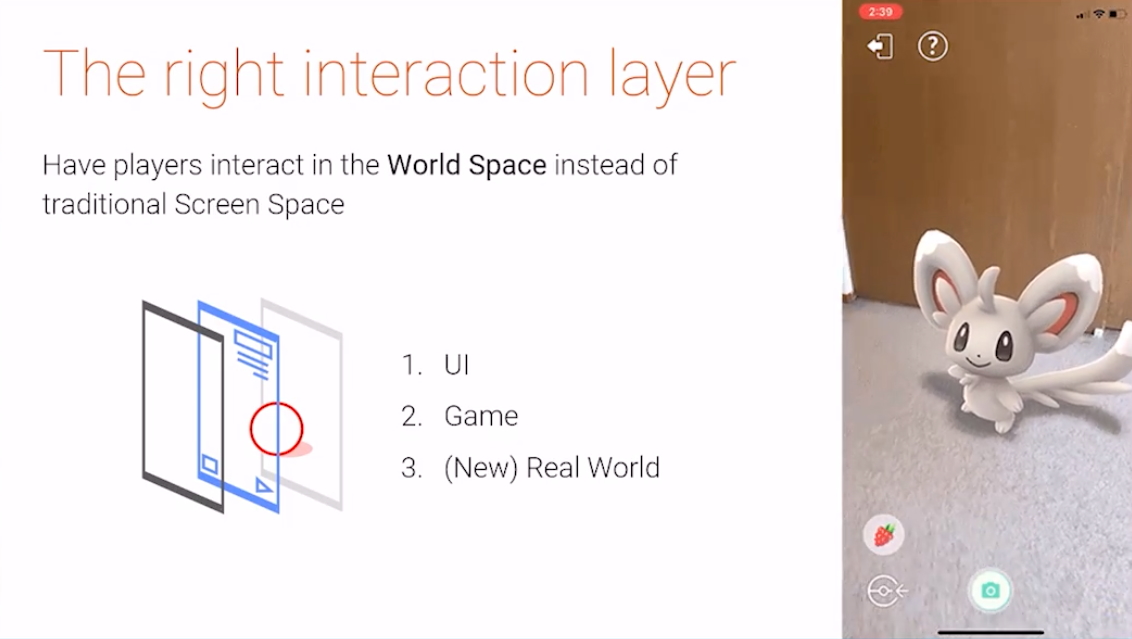
I was really looking forward to Niantic’s AR Game Design 101 panel at GDC Summer 2020 this week because for all my criticisms of the company and its games, I really do respect the fact that there’s at least one big company to point to in the augmented reality field. Especially with COVID keeping people more isolated, I’m getting a big reminder of how these games have been helping me go out and meet new people, without the interaction feeling overly contrived or even interview-esque. Even for a gamer and writer, getting an idea of what devs are thinking helps me better understand how and why game feature choices are made, even when said knowledge doesn’t match up with the execution.
Best practices but not realities
Niantic’s Senior Game Designer Laura Warner and Senior Software Engineer Kirsten Koa were our presenters, and I think it’s important to note that these two joined the company after Pokemon Go’s rocky first year. From my personal research, unlike the majority of the initial team beyond a few key higher-ups, Warner and Koa not only have experience with non-Google companies prior to joining Niantic but also had game-specific experience. While POGO clearly leaned on the Pokemon IP to launch, better game design has certainly saved it as other Pokemon mobile titles drowned, sometimes soon after launching. No one is perfect, but as someone who has watched and spoken with Niantic employees for years, I can say that the newer blood often comes across as more relatable as both players and game-specific developers, which is important since as vital as engineers and technicians may be, we judge games as games, not as tech apps.
So it shouldn’t have surprised me Warner and Koa were able to show the audience that Niantic does have practical knowledge of AR despite multiple complaints about basic useability from industry vets, even if said design choices may have accidentally created some good ones. That’s key because, as I said in the previous GDC Niantic article, Niantic’s game pillars are Exploration, Exercise, and Socialization, so something like having bad UI that leads to socialization and exploration actually supports company goals – which is unique if a bit confusing for traditional game development. While it wasn’t explicitly said, I took the presentation as being more about best practices rather than what the company may actually practice, as the juxtaposition may reveal.
Do as I say
While I’ve made note of previous issues at release that made the game a bit anti-social (if not dangerous), a lot of those criticisms still apply. Niantic must know this, as we were reminded that AR games, unlike traditional games, involve the real world, physical location, and player as avatar (something Raph Koster has talked about for ages, even outside of games), all of which hopefully lead to creating real-world memories. The game also works in different layers. You don’t simply have the UI allowing you to interact with the game; the game also interacts with the real world.
Most of what Warner and Koa spoke about was specifically about mechanics, like paying attention to how shadows, lighting, ground planes, depth, and scale affects immersion when your game overlaps with visual representations of the world in front of the player. It was also good to hear that the company recognizes that AR gameplay is not a social norm.
Upfront, the Niantic reps said that VR creates self-contained spaces, but AR is in shared spaces. This puts stress not only on a player who doesn’t want to stand out in a negative way but also on those around them. The presenters suggested keeping players “moving and doing active gestures” to avoid this and focusing game assets on ground or sky so the player hopefully won’t be aiming a camera at a stranger’s face.
This isn’t just practical advice; it mirrors suggestions critics besides me have long offered, not just for POGO but for Ingress as well. In fact, not only had I made personal notes of problematic Ingress play I’d seen in anticipation of Pokemon Go’s 2016 release, but I had given the game a shot after release to try to better understand the two games, and I still came away disappointed.
For example, both games encourage people to stop and actively play the game, which, hey, it’s totally fair if you ignore the exercise portion of the game, but we all need a cooldown. Niantic’s reps mentioned that they try to keep AR activities between 30 seconds to two minutes with plenty of long breaks because most digital games don’t require exercise and AR games aren’t the norm, so it’s best to keep that action bite-sized for now as players get used to the genre.
What’s not fair is this is asking players to stop and play while they are outside, in public, and sometimes in problematic areas, such as actively controlled government property. Yes, the game warns people to be aware of their surroundings, but various mechanics such as limited spawns and timed events work against this.
That’s odd because the team also advised AR developers not to limit players’ time and allow them to move at their own pace. But HPWU and POGO itself tells a different story: When spawns disappear, when events/consumables are of a timed nature, or when you’re trying to play with others, such advice to fellow devs rings hollow.
Imagine having enough people to make two baseball teams standing around the “Welcome” sign to your town, clamoring at your local coffee shop’s entrance, or loitering on a narrow trail. Heck, imagine getting off the bus and having someone turn into you as they realize they walked too far away to catch a virtual creature. Now imagine that these aren’t just hypotheticals, or even just my personal experiences, but under normal conditions are normal, daily parts of being in an environment with game players. I don’t even mean playing the game but simply being in the gamers’ shared space during your everyday life outside your home. While it can lead gamers to meeting each other or encourage someone to start the game, it also can lead to negative run-ins with hostile neighbors, law enforcement, or even fellow gamers looking to settle virtual rivalries in the physical world.
And what’s upsetting is that Niantic not only has the means to better control these actions but has the knowledge and systems in place that already achieve this in certain areas of the game, some of which are also already monetized.
The original PvP matchmaking system that required a player to walk a certain amount before participating in the game action was actually a really good design choice by Niantic’s own design goals because it encouraged people to go out for exercise while making the content it unlocked available in the safety of one’s choosing, plus it could be purchased if a player wanted to skip the exercise for the day. For heavy cardio fans, the background limit might encourage a player to at least start PvP attempts prior to going home, but Niantic could have increased the background stack amount players could save.
The recently added remote raid passes that let you raid from home do the same thing, though this is largely permissible only as premium content, not basic gameplay, and for rural players it may only work if someone near a gym invites them. What I find most interesting is that many changes, such as raiding from home, large spin radii, increased space for gifts, and higher limits on opening said gifts are all things players had asked for in the past in order to cut down on the pressures of doing, well, everything while out in the field.
One major saving grace, in my opinion, is the Go Plus and related peripherals that allow a player to simply hit a button for a chance to spin a stop or catch a pokemon without having to constantly look at the phone and (ideally) hunt for a safe place to stop and play the game – which is almost constantly unless (again) playing in rural areas. The Plus also addresses advice given by the team to ensure that AR games allow players to look up and around to check their surroundings, as the device vibrates differently depending on several factors. In essence, the Plus already supports a lot of the advice Niantic was giving during the panel that the POGO base game didn’t follow.
I tried asking the team about how and when it decided to use an additional device to discourage anti-social behavior or at least cut down on screen time for other titles (after admitting that, of all the Niantic and even AR games I’ve played, my Plus is probably a big reason why I’m still in POGO). The reply was a non-answer: “The Pokémon Go Plus and the Poké Ball Plus are such fun ways to stay connected to the game and we love working with our partners on those devices!”
The developers also mentioned the Adventure Sync option that counts your steps while the game is off (and the feature also notifies you if there’s a Pokemon you haven’t caught nearby), but that’s not nearly on the same level as the Plus, which drastically helps to cut down on grinding for both pokemon and supplies to capture and battle them.
Furthermore, device integration is supposed to be part of the game’s narration. While this makes sense with Star Wars: Galaxy’s Edge’s cellphone as a datapad, my phone doesn’t seem like it’s part of the Pokemon narration at all, aside from the rare moments I take pictures of pokemon for fun instead of for required tasks. The Plus sadly doesn’t help this much either, but the Pokeball Plus does in that it’s a real-world representation of a game item and acts as a cross-media connection to other Pokemon games. It is admittedly more embarrassing to carry around if I want to play alone, but is both fun and immersive when playing with fellow players or even walking a pet. The fact that the device probably works more as a series tie-in than a way to improve basic gameplay immersion and solve the screen problem is discouraging.
On accounting for accessibility, the Niantic representatives said that, “Accessibility is something that is so important, and a space [they’re] still exploring and doing [their] best to learn about in the AR space! [They’ve] really focused on physical fatigue as a starting point but [are] looking forward to learning and growing further in that space.” It’s nice that something’s going on there, and consciously or not, various colored buttons (such as for types and teams) also having different icons associated with them helps colorblind players in many (but not all) situations. But this goes back to how many of the recent COVID changes are things players had suggested long before the pandemic, such as expanding spin radii so areas that aren’t handicap accessible wouldn’t also be so out of reach for players.
It’s not as if Niantic doesn’t prototype. Not only does it internally test features with teams not working on the game a feature may be made for, but it also uses player research teams, which I imagine are the influencers and select tech press the company has traditionally favored. While anyone could give feedback on how immersion-breaking being inside Pikachu’s head is when taking AR pictures is (a real problem brought up in the panel), so many blunders were made in the early days of the game that despite the vast improvements to the game and patches, nearly every mistake brings the community’s memory back to the early days when the company released content that would literally make the game unplayable for sizeable portions of the community.
I’m not sure if the process has changed over time, but we were told that now, the idea behind prototyping is to see what’s fun, inform design decisions that may not be fully understood when limited to paper suggestions, and foster collaboration. For example, the fix the previously mentioned “inside Pikachu’s head” issue, the team tried making the pokemon disappear or a cloud of smoke to indicate they’d fled. However, getting the pokemon in the right position could be difficult, so rather than forcing this into a bigger issue (and understanding that not all devices will have great AR experiences), they went with the “too close” screen, which naturally got people to move away from the Pokemon. Each prototype needs a purpose, should be put into stakeholder’s hands, and result in feedback.
Of course, how much of this the team listens to is up to the members, such as with the coin revamping system’s new release in Germany and Taiwan after Australian players have been complaining about it for months. The numbers have changed, but the basics, such as needing to do a raid (100 coins unless using the free pass to raid in person) to earn only part of the possible 50 coins you can earn a day, still make no sense, especially during COVID.
It was great to hear from newer Niantic team members who were responsible for features that really feel like they’re saved the game, but the panel was also supremely disheartening because it was a development 101 chat for developers giving basic advice that simply isn’t being followed by the host company doing the teaching, at least as judged by three out of three of its own released consumer products.
 Massively OP’s Andrew Ross is an admitted Pokemon geek and expert ARG-watcher. Nobody knows Niantic and Nintendo like he does! His Massively on the Go column covers Pokemon Go as well as other mobile MMOs and augmented reality titles!
Massively OP’s Andrew Ross is an admitted Pokemon geek and expert ARG-watcher. Nobody knows Niantic and Nintendo like he does! His Massively on the Go column covers Pokemon Go as well as other mobile MMOs and augmented reality titles!



















